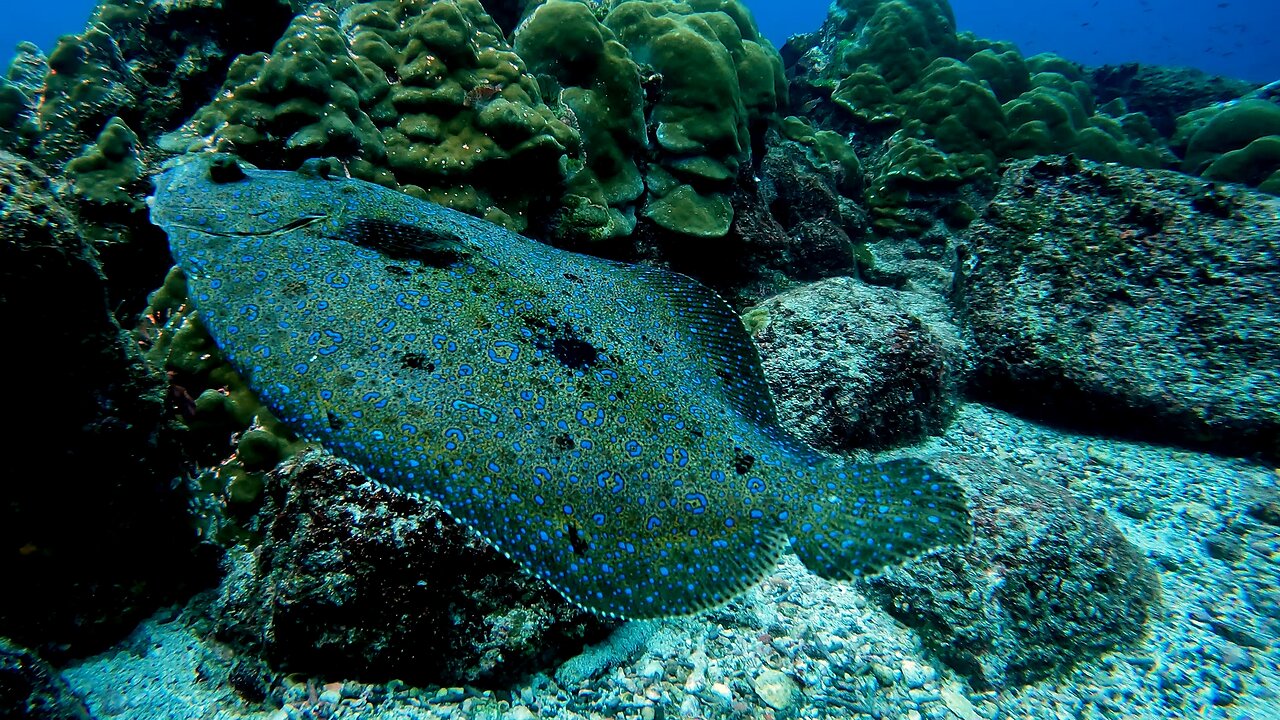Premium Only Content

Peacock flounder displays beautiful color and camouflage ability
Peacock flounders are beautiful fish that use their color-change abilities to mimic their surroundings to hide from predators. They can become blue, green, grey, beige, and other colors. They can change their patterns as well in order to match the surface that is beneath them. Flounders can change their color and markings in seconds, even well enough to match a checkerboard pattern. They lie flat on the bottom in order to disguise themselves, and also to ambush their prey.
A unique feature of flounders is that they begin life in a vertical position with their flattened bodies resembling most other fish. They have a eye on each side of their head and a mouth that opens and closes vertically, as with other fish. But, as they mature, one of the flounder's eyes migrate from one side to the other, causing them to swim flat, instead of vertically. The eye that migrates is different, depending on the species. In the case of the peacock flounder, the right eye migrates to the left side. As an adult, the flounder is able to look forward with one eye and backward with the other, simultaneously. The eyes are raised like short stumps, allowing the flounder to bury itself in sand for even better camouflage. The eyes protrude slightly, allowing the flounder to see its surroundings while it hides.
Peacock flounders can reach a maximum length of 45cm (1.5 feet) and can be found in depths up to 150m, although they prefer shallower areas with a sandy or rocky bottom. The Peacock flounder releases two to three million eggs which are fertilized by the males. The eggs float near the surface until they are ready to hatch. They sink to the bottom as they hatch. The juvenile flounders float in the open ocean, with their eyes beginning to migrate as they mature.
The color matching process of the flounder is not well understood but we know that it relies on vision and hormones. If the flounder suffers damage to one eye, it's ability to color change is adversely affected. Flounders are fascinating and beautiful fish and a welcome sight for scuba divers.
-
 6:00:08
6:00:08
SpartakusLIVE
8 hours agoYoung Spartan STUD teams with old gamers for ultimate BANTER with a SMATTERING of TOXICITY
23.9K -
 1:50:39
1:50:39
Kim Iversen
9 hours agoShocking Proposal: Elon Musk for Speaker of the House?! | IDF Soldiers Reveal Atrocities—'Everyone Is a Terrorist'
69.3K149 -
 43:27
43:27
barstoolsports
12 hours agoOld Dog Bites Back | Surviving Barstool S4 Ep. 9
125K3 -
 5:13:04
5:13:04
Right Side Broadcasting Network
7 days agoLIVE REPLAY: TPUSA's America Fest Conference: Day One - 12/19/24
178K27 -
 1:06:01
1:06:01
Man in America
1 day agoPfizer Has Been Caught RED HANDED w/ Dr. Chris Flowers
56.9K15 -
 2:24:15
2:24:15
Slightly Offensive
10 hours ago $17.12 earnedAttempted ASSASSINATION of Nick J Fuentes LEAVES 1 DEAD! | Guest: Mel K & Breanna Morello
42.6K28 -
 1:43:08
1:43:08
Roseanne Barr
9 hours ago $27.56 earned"Ain't Nobody Good" with Jesse Lee Peterson | The Roseanne Barr Podcast #79
81.8K36 -

The StoneZONE with Roger Stone
6 hours agoTrump Should Sue Billionaire Governor JB Pritzker for Calling Him a Rapist | The StoneZONE
51.6K5 -
 1:36:58
1:36:58
Flyover Conservatives
1 day agoAmerica’s Psychiatrist Speaks Out: Are We Greenlighting Violence? - Dr. Carole Lieberman | FOC Show
34.9K6 -
 6:44:54
6:44:54
LittleSaltyBear
8 hours ago $3.13 earnedNecromancing Path of Exile 2 4K
30.5K4